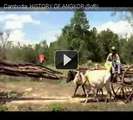Cambodia: HISTORY OF ANGKOR (6of6) [in english language]
The inscriptions often mention the date, and sometimes the precise moment, at which a statue was 'brought to life' (the text speaks of 'opening a statue's eyes'), which was the crucial instant in the life of the temple. There was no solemn ceremony for the inauguration of a temple on its completion (which would have been difficult to determine exactly), nor one for laying the first stone. We know, however, that the Indian Shastras which laid down the rules of architecture, emphasised the extreme importance of the initial ceremonies for a building, and this is well attested by the presence of various 'foundation offerings' deposited beneath the actual foundations of the shrine, and also beneath the pedestals of the statues (which is why they have all been overturned by thieves), or even at the summit of the towers. The offerings were deposited in a square flagstone with various cavities, some of which were marked by letters and covered with a lid. In these cavities, precious stones, thin gold leaves, or even strands of hair or nail-clippings from the donor's body, were placed.
"Art flourished in Kamboja as never before, centered around a capital city known to all Asia as Angkor, the Magnificent, a city of more than a million inhabitants - which when it was extricated from the jungle in modern times, contained not a single human being.
Chinese and Indian envoys could hardly believe their eyes when they gazed at the splendid temple of Angkor Vat, a sublime work of art that was inspired by India but shaped by the genius of Khmer people." Robert Joseph Casey
Angkor wat is often hailed as one of the most extraordinary architectural creations ever built, with its intricate bas-reliefs, strange acoustics and magnificent soaring towers. Angkor Wat, originally named Vrah Vishnulok - the sacred abode of Lord Vishnu, is the largest temple in the world. It was built by King Suryavarman II in the 12th century. The Sanskrit Nagara (capital) was modified by the Cambodian tongue to Nokor and then to Angkor. The word Angkor is derived from the Sanskrit word 'nagara' meaning 'holy city'. Vatika is Sanskrit word for temple. "The city which is a temple," Angkor Wat is a majestic monument, the world's largest religious construction in stone, and an architectural masterpiece. The Khmers adhered to the Indian belief that a temple must be built according to a mathematical system in order for it to function in harmony with the universe. Distances between certain architectural elements of the temple reflect numbers related to Indian mythology and cosmology. The sheer size of the place leaves visitors in awe and the complex designs illustrate the skills of long gone priest architects. Every spare inch has been carved with intricate works of art. The sculptures of Indian icons produced in Cambodia during the 6th to the 8th centuries A D are masterpieces, monumental, subtle, highly sophisticated, mature in style and unrivalled for sheer beauty anywhere in India says Philip Rawson. The scale of Angkor Wat enabled the Khmer to give full expression to religious symbolism. It is, above all else, a microcosm of the Hindu universe.
It is frequently said that Angkor was 'discovered' by the Europeans but this is patently nonsense and simply reflects a Eurocentric view. The Khmer never forgot the existence of their monuments. French naturalist Henri Mouhot stumbled across the city complex of Angkor Wat while on a zoological expedition. He was overwhelmed by the magnificence of these ruins hidden in the jungle and wrote: "One of these temples -- a rival to that of Solomon, and erected by some ancient Michael Angelo - might take its place besides our most beautiful buildings -- Grander than anything left to us by Greece or Rome ...it makes the traveler forget all the fatigues of the journey, filling him with admiration and delight, such as should be experienced on finding a verdant oasis in the sandy desert."
![]()





No comments:
Post a Comment